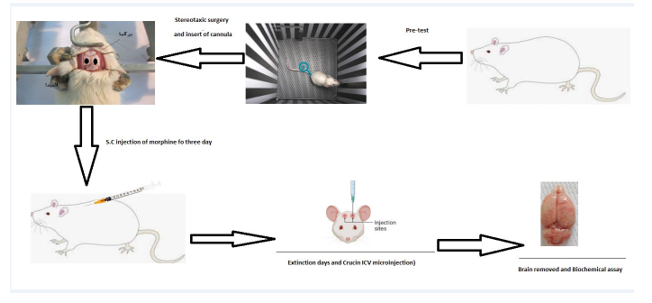BibTeX | RIS | EndNote | Medlars | ProCite | Reference Manager | RefWorks
Send citation to:
URL: http://jmums.mazums.ac.ir/article-1-20027-en.html
Background and purpose: The reward system of the brain plays a critical role in regulating behavior in both humans and animals. Crocin, the active component of saffron, has been shown to reduce the symptoms of morphine withdrawal. Additionally, administration of saffron extract has demonstrated a dose-dependent improvement in morphine-induced side effects. Given crocin's influence on the brain’s reward circuitry, this study, for the first time, investigates the effects of intracerebroventricular injection of crocin on extinction and reinstatement behaviors in rats conditioned with morphine.
Materials and methods: In this animal study, a total of six control and experimental groups were used. The samples were categorized into three groups: a solvent group, a repeated crocin injection group, and a single crocin injection group. Crocin was administered via intracerebroventricular injection at the following coordinates: AP: -0.48 mm; Lat: ±1.2 mm; Depth: 4.2 mm. Behavioral observations were recorded during the extinction and reinstatement phases. At the end of the experiment, the rats were euthanized, and their brains were collected for biochemical and histological examinations.
Results: Daily intraventricular administration of crocin during the extinction period at doses of 10, 20, and 40 µg, particularly the 40-µg dose, reduced the extinction period in a dose-dependent manner, significantly shortening the number of extinction days (P < 0.001). In addition, a single effective dose of 40 µg of crocin administered intraventricularly prior to the reinstatement phase resulted in a significant change in conditioned scores compared to the post-test (P< 0.01). Biochemical findings showed that crocin caused a significant reduction in c-Fo’s expression in the nucleus accumbens (P< 0.001). Furthermore, histological analysis revealed that neuronal damage in the CA1 region of the hippocampus was reduced in the crocin-treated groups, particularly at the 40-µg dose, compared to the solvent-treated group.
Conclusion: It has been shown that crocin may be effective in modulating the brain's reward system and the neural circuitry involved in addiction.
| Rights and permissions | |
 |
This work is licensed under a Creative Commons Attribution-NonCommercial 4.0 International License. |







